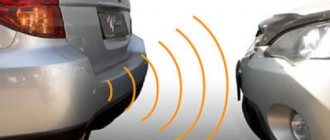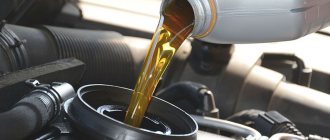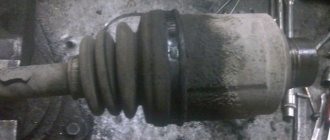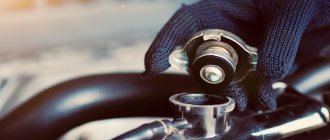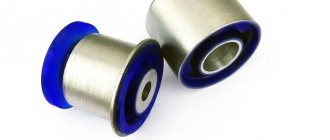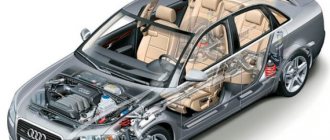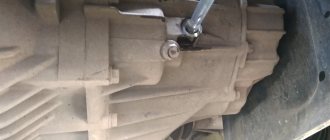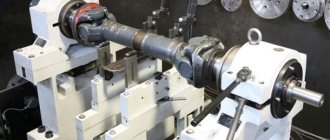Car enthusiasts know that when replacing parts in the chassis, the settings change and, as a result, the behavior of the car on the road changes. Wheel alignment geometry depends on tire wear, chassis play, tire pressure and other parameters. To achieve vehicle stability, the front wheels, as well as the rear ones, are placed at a regulated angle relative to each other, the road and body elements. In this article we will try to answer the question - when and in what cases is it necessary to do geometry (wheel alignment)?
What is wheel alignment and why is it necessary?
Wheel alignment (also called wheel alignment) is a procedure for adjusting the inclination angles of a car's wheels.
The fact is that during operation of the suspension, the wheels may be at the wrong angle, and the car will be pulled to the side while driving. On a dry road this may not be too noticeable, but in the rain the difference will be noticeable. The process of setting angles includes three components: toe, camber and caster. Wheel alignment should be done to restore the car's stability on slippery surfaces and improve its handling. A car with zero performance consumes less fuel, skids less, and its tires wear out more slowly and evenly.
When to adjust toe and camber
The manufacturer gives recommendations for performing this procedure; they indicate after what mileage this should be done. For domestic cars it is needed within 10-20 t.km, for foreign cars 25-30 t.km. It is important to remember that even if the car has not been in an accident and the chassis elements are not replaced, over time the alignment of the angles is disrupted. During operation, due to subsidence of silent blocks, shock absorber springs and other suspension elements, the parameters need to be changed. The appearance of microscopic play in connections leads to the replacement of these indicators. In this regard, experienced motorists adhere to the “golden rule” of checking the correct installation of angles at least once a year.
Extraordinary adjustment of installation angles (toe, camber) should be done in the following cases:
- when replacing shock absorber struts, stabilizer struts, ball joints, spring bearings, steering rods, racks, gearboxes and many other chassis parts;
- accelerated tire wear;
- the disc is bent as a result of the wheel hitting an obstacle and requires replacement or restoration;
- spontaneous pulling of the car to the side;
- changing the ground clearance parameter by shortening or lengthening the spring;
- replacing tires with tires of a different size;
- at the end of the turn, the steering wheel does not return to its original position;
- during seasonal tire replacement;
At the same time, when replacing many parts, if there is confidence that the settings have not been lost, an experienced driver can make adjustments at will, just to be on the safe side. Because Based on the behavior of the car, an experienced driver will quickly determine the advisability of such adjustment.
How do you know when to do the procedure?
Car trips do not always take place on clean, repaired roads. But even on ideal Japanese and German autobahns, tires and suspension experience enormous loads, what can we say about broken Russian roads: braking, acceleration and sharp turns negatively affect the position of the wheel tilt angle. To correct this, you need to do a wheel alignment regularly.
Tire manufacturers recommend setting suspension parameters along with all scheduled vehicle maintenance. Owners of domestic cars need to visit a car service center every 15-20 thousand km; for foreign cars, a frequency of 30 thousand km is allowed. It is important to keep in mind that you can only trust it to professionals in tire centers, since it is not so easy to correctly adjust the angle yourself without special equipment.
The longer the wheel alignment is ignored, the more serious the unpleasant consequences will be, and therefore the likelihood of an accident. At severe angles, holding the steering wheel and correcting the course will become more and more difficult due to the smaller contact patch with the highway. Even a new car does not guarantee proper balancing - dealers often ignore setting the balance.
Adjustment is necessary if:
- The car constantly pulls to the side when driving in a straight line and has to be steered back;
- The wheels quickly wear out on the sides and “squeal” even at low speeds;
- The steering wheel does not return to its place on its own if you release it, or it has a different radius when rotating left and right;
- Exchange rate stability at high speeds has deteriorated;
- The car “floats” in the rut;
- Different rotation angle;
- The car has very poor steering response, the steering wheel shakes when driving, i.e. "beating" is observed.
The cause may be a recent suspension repair.
Wheel alignment on a car must be carried out after replacing ball joints, levers, steering rods, struts, CV joints, steering ends and springs. However, no one obliges you to set the parameters if you have changed tires, shock absorbers or stabilizers. Replacing these elements does not have any effect on the suspension, so do not believe those employees of the automotive center who are trying to force an unnecessary service on you. Violation of the angle of rotation of the wheels on a car can also occur due to strong shock loads or constant driving on broken roads.
Drivers who prefer an aggressive driving style should first consider visiting a tire shop. A side impact that leaves a dent on the disc is a good reason to go to the auto center. A wheel falling into a hole or a minor accident can also throw off the angle and seriously affect the suspension.
Wheel alignment angles, what is affected by this value
Co.
Structurally, the suspension of most cars has the ability to adjust the wheel alignment. This procedure is necessary so that upon completion of the replacement and adjustment of parts, the person driving the car will enjoy driving from correctly installed front wheels. In addition, this is one of the important factors determining traffic safety. When developing the suspension project for the front and rear wheels, specialists took into account that after each repair or replacement of products of this unit, it is necessary to adjust the angles of inclination. The manufacturer has stipulated possible deviations from the specified parameters, which have minimum values expressed in units, fractions of arcseconds. Typically, automotive engineers talk about multiple installation angles. They have a great, or rather, decisive, impact on the dynamics, controllability and efficiency of the machine.
Their list is as follows:
- camber;
- convergence (convergence);
- caster and others;
The first parameter is presented in the form of the angle of inclination of the wheels relative to the road surface. It can be positive (the upper side of the slope is directed upward and outward) and negative (its upper part is inclined inward). Each of these provisions has pros and cons. The correct inclination of the front wheels is necessary to ensure good traction and stable control. The toe angle must be understood as the difference in distances measured at the lower and upper points of the wheels. A sign of deviation from the indicators regulated by the manufacturer is accelerated severe wear, leading to frequent replacement of tires and increased fuel consumption. Toe is measured in millimeters and also degrees/minutes. Caster is the longitudinal angle of inclination of the king pin; it is needed to stabilize steering and self-align the wheels.
What is collapse?
Camber is the angle between the plane of rotation of the wheels and the vertical, or simply their deviation from the vertical straight line. It is measured in degrees. Improper camber leads to accelerated tire wear. There are also two types:
- Negative means that the upper parts of the wheels of one axle are closer to each other, and the lower parts are further away - in the form of a “house”. Strong minus camber is achieved in light racing cars, so that the sports car can more easily corner at high speeds. But such extreme values will quickly eat up the tread, so they are only suitable for professional teams that can change several sets of tires per race.
- If it’s positive, it’s the other way around—the upper parts are located further apart than the lower parts. This angle is created deliberately in heavy trucks and straightens to zero when the vehicle is loaded. The greater the load on the body, the more the distance between the lower parts of the wheels increases, moving to a negative value, which improves handling, but this way the tires wear out much faster.
Zero camber is most acceptable for most passenger cars, but only if the suspension is stiff enough. On older cars, positive camber was often installed so that the load compensated for it and straightened it to zero values.
Is it possible to perform a wheel alignment yourself?
Many car owners love their cars very much and do everything on them themselves. But in order to do a competent wheel alignment, you need to have special equipment. Modern computer stands, where alignment is performed on the basis of sensors, the readings from which are processed by a computer, are very expensive. But you can also take an optical stand. Nowadays they are practically not used at service stations, because it is more time-consuming and more complex. But if you have free time, enthusiasm and your own garage with electricity, then you can buy such a stand; they are not expensive, and if you find them second-hand, they cost just a penny.
Article on the topic: How to make distilled water at home
What is toe-in?
Toe is the angle between the plane of rotation of the wheel and the longitudinal section of the car, or, in other words, the horizontal. It determines the steering behavior. This indicator is measured in degrees, minutes or millimeters. There are two types of convergence:
- A positive is noted if the front parts of the wheels of one axle are closer to each other than the rear parts. Focusing on this option for the front wheels makes the car more stable at high speed, but it turns worse.
- A negative suggests that the fronts deviate further from each other than the rears. If the front axle is configured with an emphasis on negative toe, the car will handle better, but it will begin to have wear problems, and the steering wheel will become extremely sensitive to all road irregularities.
Getting the alignment right is much more important than correcting the camber. Due to an incorrect horizontal angle, the car will handle worse and consume more fuel due to strong rolling resistance, and tire wear will increase significantly. Wheels with incorrect alignment may not survive thousands of kilometers. So for everyday driving it is important to adjust the toe to zero - this way the driver will avoid the “professional” problems faced by drifters and other fans of experimenting with the suspension.
Instructions for adjusting wheel alignment yourself
Before you begin adjusting the camber and toe angles, it is imperative to check the vehicle's chassis. If repairs are needed, then doing a wheel alignment is pointless. The steering and suspension must be in perfect order.
Pay attention to three points on which the wheel alignment angles on a car greatly depend:
Be sure to check the tire pressure before adjusting the wheel alignment and make sure that you haven’t accidentally forgotten a couple of bags of potatoes or cement in the trunk

